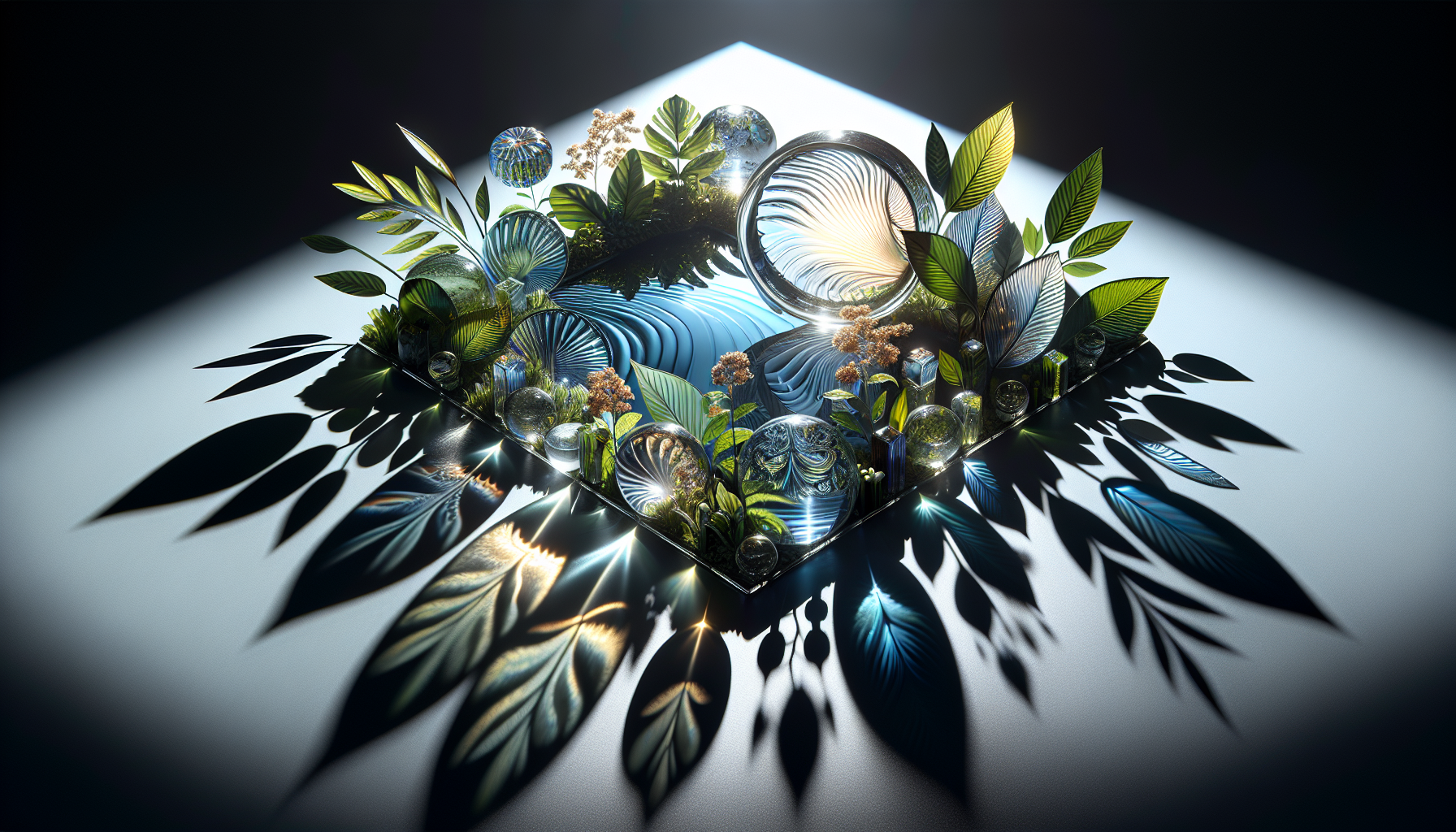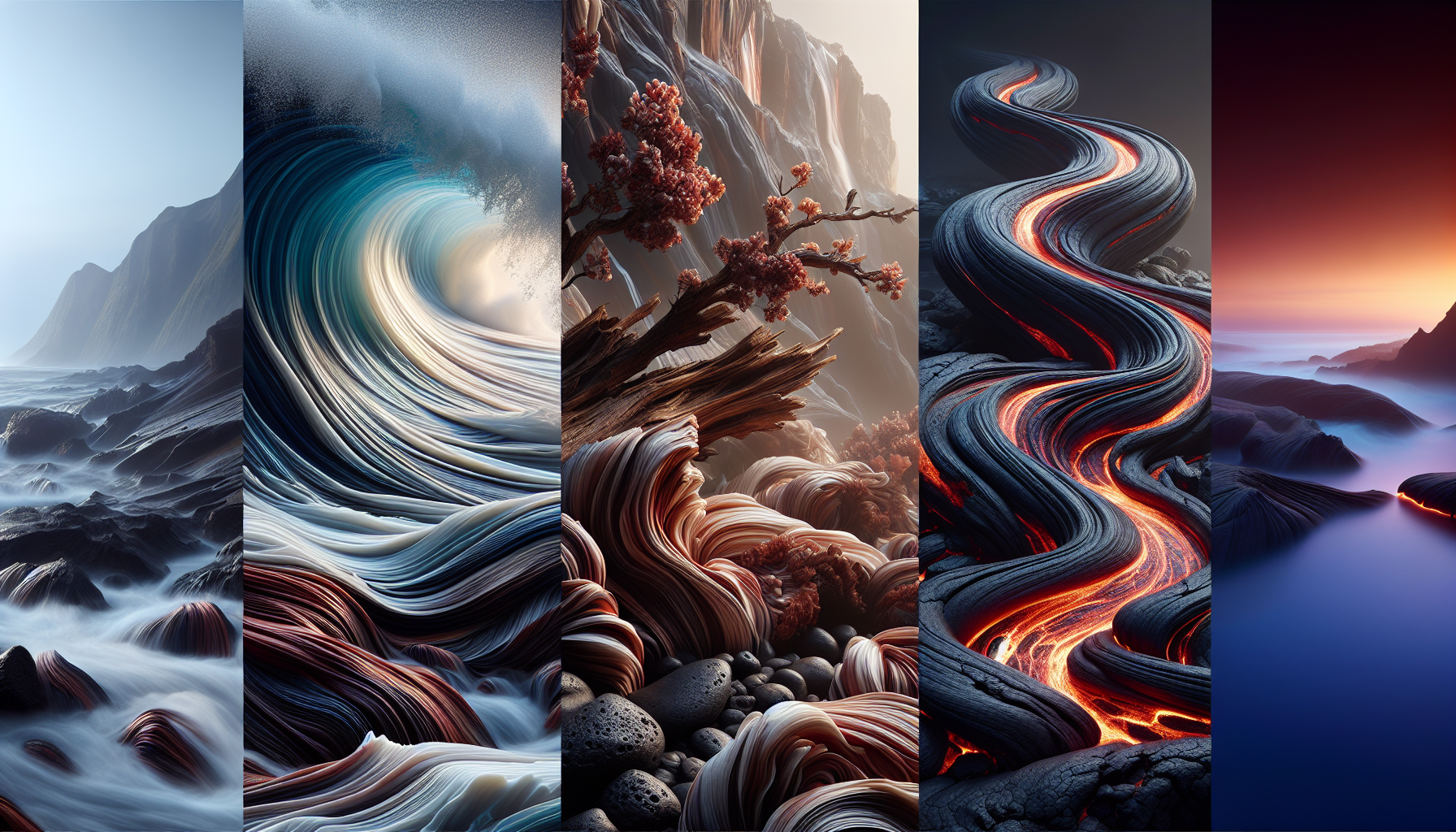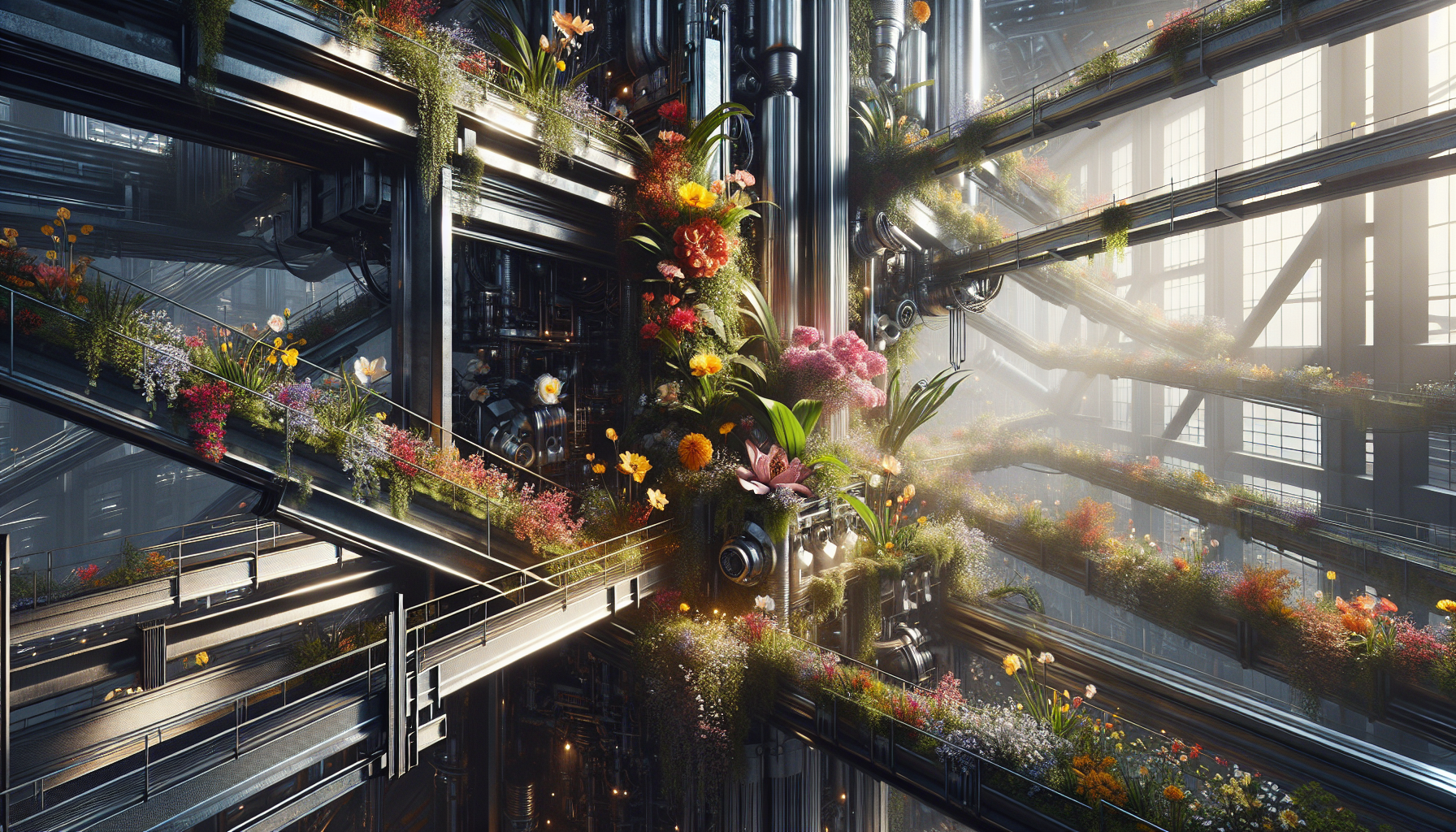Anúncios
In the ever-evolving world of design, where innovation meets artistry, there emerges a captivating trend that bridges the gap between nature and human creation: glass designs inspired by the inherent beauty of our natural surroundings. 🌿 This fascinating interplay between the organic forms of nature and the sleek, modern aesthetic of glass art is transforming how we experience and interact with our environments. By mirroring the elegance and intricacy of the natural world, these designs not only captivate the eye but also evoke a deeper sense of connection to the earth. As we delve into this enthralling subject, we will uncover the essence of how nature’s splendor can be immortalized through the medium of glass, inviting us to reflect on the symbiotic relationship between the two.
At the heart of this exploration lies the question: how do artists and designers draw inspiration from nature to create glass pieces that resonate with both beauty and purpose? Nature has long been a muse for creators, offering an endless array of colors, textures, and forms. From the delicate patterns found in leaves to the flowing curves of water and the complex structures of crystals, the natural world provides a rich tapestry of elements that can be reimagined in glass. This article will illuminate the techniques and philosophies that underpin this creative process, showcasing how artisans capture the essence of nature’s allure in their work, while maintaining a harmonious balance between form and function.
Anúncios
As we journey through the landscape of glass design, we will encounter a variety of innovative approaches that highlight the versatility and transformative power of this medium. From the use of biomimicry, where designers emulate the functional aspects of natural systems, to the incorporation of organic motifs and textures, each piece tells a story of its own. We will delve into the world of renowned artists who have mastered the art of translating nature’s beauty into stunning glass creations, examining their inspirations, methodologies, and the impact of their work on both the art world and the broader sphere of environmental awareness. By doing so, we aim to inspire not only appreciation for these exquisite works of art but also a renewed commitment to preserving the natural world that fuels such creativity.
Ultimately, this exploration is not merely about the aesthetic appeal of glass designs; it is about the profound impact they have on our perception of nature and our place within it. 🌍 In a world increasingly dominated by technology and urbanization, these designs serve as a poignant reminder of the importance of maintaining a connection to the natural world. As we navigate through the pages of this article, we will reflect on the potential of glass art to foster a deeper appreciation for the environment, encouraging sustainable practices and mindful living. Join us as we embark on this journey through the captivating realm of organic reflections, where the beauty of nature and the artistry of glass converge to create a symphony of inspiration and wonder.
The Intersection of Art and Nature in Glass Design
Glass design has always been a captivating aspect of artistic expression, blending functionality with aesthetics. When infused with the beauty of nature, these designs become even more enchanting, offering a reflection of the organic world through a transparent medium. This fusion of art and nature is not only visually appealing but also evokes a sense of serenity and connectedness to the environment. Glass designs inspired by nature’s beauty capture the essence of organic forms, textures, and colors, allowing us to bring a piece of the natural world into our everyday lives.
Anúncios
Incorporating natural elements into glass design involves a delicate balance between creativity and technique. Designers must understand the intricacies of both glass as a medium and the natural forms they wish to replicate or evoke. This often requires innovative approaches, such as using advanced glassblowing techniques, intricate etching, and layering to create depth and complexity. The results are often breathtaking, with pieces that mimic the delicate veins of leaves, the fluidity of water, or the iridescence of a butterfly’s wings.
Moreover, the trend of nature-inspired glass design is part of a larger movement towards sustainable and eco-friendly art. By drawing inspiration from nature, artists and designers highlight the importance of preserving the environment and using resources responsibly. This conscious approach not only adds depth to the artistic process but also encourages viewers to consider their relationship with nature. As you delve deeper into this topic, watch the following video for a visual exploration of nature-inspired glass art: Captivating Glass Art – Nature Inspired Designs (Channel: Artful Glass Creations).
Techniques in Nature-Inspired Glass Design
The creation of glass art that captures the essence of nature requires a mastery of various techniques. One of the most popular methods is glassblowing, which allows artists to shape molten glass into organic forms. This technique is often combined with others, such as etching and engraving, to add intricate details that mimic the textures found in nature. For example, artists may use engraving to recreate the fine lines of a leaf or the rough texture of tree bark.
Another technique frequently employed in nature-inspired glass design is the use of color and translucency. Artists often incorporate natural colors such as greens, blues, and earthy tones to reflect the hues found in the natural world. Translucent glass can also be layered to create a sense of depth and movement, akin to the way sunlight filters through leaves or water. This play of light and color can transform a simple glass piece into a dynamic work of art that changes throughout the day.
Moreover, some artists experiment with incorporating natural materials directly into their glass designs. For instance, small twigs, leaves, or flowers can be encased within the glass, creating a literal representation of nature’s beauty. This technique not only adds visual interest but also introduces a tactile element, inviting viewers to engage with the piece in a multi-sensory way. To see some of these techniques in action, check out the video below.
Comparative Analysis: Traditional vs. Nature-Inspired Glass Designs
While traditional glass designs often focus on symmetry, precision, and function, nature-inspired designs prioritize organic shapes, textures, and a connection to the environment. Traditional designs might include geometric patterns or classic motifs, whereas nature-inspired designs draw directly from the natural world, such as the curves of a shell or the flow of a river. The table below offers a comparative analysis of these two approaches:
AspectTraditional Glass DesignNature-Inspired Glass DesignShapeSymmetrical, geometricOrganic, free-formTechniquePrecision cutting, uniformityBlowing, engraving, texturingColorSolid, classic tonesNatural, varied huesInspirationHistorical, architecturalNatural elements, landscapes
The Impact of Nature-Inspired Glass Design on Interior Spaces
Incorporating nature-inspired glass designs into interior spaces can significantly enhance the ambiance and aesthetic of a room. These designs often serve as focal points, drawing attention and admiration from guests. The organic shapes and natural colors of these pieces can create a calming and harmonious environment, making them ideal for spaces meant for relaxation or contemplation, such as living rooms, bedrooms, or meditation areas.
Furthermore, nature-inspired glass designs can help to bridge the gap between indoor and outdoor spaces. Large glass installations that mimic the forms and colors of the natural world can create a seamless transition from interior to exterior environments. This is particularly effective in homes with large windows or open floor plans, where the glass pieces can complement the views of the surrounding landscape.
For those interested in incorporating these designs into their homes, there are a variety of options available. From large, statement-making pieces to smaller, subtle accents, nature-inspired glass art can be tailored to suit different tastes and styles. Whether you prefer a minimalist aesthetic or a more eclectic approach, there’s likely a glass design that can enhance your space. As you consider these possibilities, take a moment to watch the video linked above for additional inspiration.
The Role of Light in Enhancing Glass Designs
One of the most captivating aspects of glass design is its interaction with light. When strategically placed, glass pieces can transform a space through their play of light and shadow. Nature-inspired designs, in particular, can cast intricate patterns and colors that shift throughout the day, adding a dynamic element to any room. This interplay between light and glass can create a sense of movement and vitality, enhancing the overall atmosphere.
To fully appreciate the beauty of these designs, it’s important to consider the lighting conditions in your space. Natural light is ideal for showcasing the colors and translucency of glass, while artificial lighting can be used to highlight specific features or create a particular mood. For instance, backlighting can be used to emphasize the details of an etched design, while soft ambient lighting can create a warm and inviting glow.
Whether you’re an artist looking to explore new creative avenues or a homeowner seeking to elevate your interior design, nature-inspired glass art offers endless possibilities. With its ability to capture the essence of nature and transform it into something tangible and beautiful, this art form continues to inspire and captivate. Don’t forget to explore the resources provided in this article for further insights and inspiration.

Conclusion
**Conclusion: Captivating Organic Reflections: Glass Designs Inspired by Nature’s Beauty**
As we draw to a close on our exploration of “Captivating Organic Reflections: Glass Designs Inspired by Nature’s Beauty,” it’s essential to revisit the profound insights shared throughout this article. The journey we embarked upon showcased how nature’s inherent elegance and complexity have the power to inspire stunning glass designs that capture the essence of the natural world. From the intricate patterns of leaves to the fluidity of water and the brilliance of celestial bodies, nature offers an endless palette of inspiration for artists and designers alike.
Throughout this discussion, we delved into the various facets of glass design, examining the innovative techniques employed by artisans who strive to replicate the organic beauty of nature. We highlighted key processes such as biomimicry, where designers emulate nature’s forms and functions to create visually arresting and functional pieces. This approach not only honors the aesthetics of the natural world but also fosters sustainable practices, emphasizing the importance of eco-friendly design in our modern era. 🌿
Furthermore, we explored the historical evolution of glass art, noting how different cultures have drawn inspiration from nature to create pieces that are both functional and decorative. From ancient Roman glasswork to contemporary installations, the influence of nature has remained a constant, underscoring the timeless connection between our environment and artistic expression. The synergy between nature and glass design is not merely a trend but a testament to the enduring appeal of organic beauty and its ability to evoke emotion and reflection.
An important theme that emerged was the role of technology in advancing glass design. Innovations such as 3D printing and digital modeling have opened new avenues for artists to experiment with complex shapes and textures, pushing the boundaries of what is possible in glass art. These technological advancements allow for a deeper exploration of natural forms, resulting in pieces that are as intricate and dynamic as the ecosystems that inspire them. Yet, despite these modern tools, the essence of the craft remains rooted in a profound respect for nature’s intricacies.
The significance of this theme extends beyond the realm of art and design. It serves as a reminder of the importance of preserving our natural world, as it continues to inspire and sustain us. By drawing inspiration from nature, artists not only pay homage to its beauty but also raise awareness of environmental issues, encouraging a dialogue about sustainability and conservation.
In conclusion, the intersection of glass design and nature’s beauty is a fertile ground for creativity and innovation. It invites us to look closer at the world around us, to appreciate the intricate details that often go unnoticed, and to find inspiration in the everyday wonders of nature. As you reflect on the insights shared in this article, I encourage you to consider how you might incorporate these principles into your own life or work. Whether you are an artist, designer, or simply someone who appreciates beauty, there is much to learn from the harmonious relationship between nature and design.
Feel inspired to share your thoughts or experiences related to this theme in the comments below. Your perspective can enrich the conversation and inspire others to explore the captivating world of glass design. Additionally, if this article resonated with you, consider sharing it with others who might also find joy and inspiration in the fusion of nature and art.
Finally, I invite you to delve deeper into this subject through the following resources, which provide further exploration of glass art and its connection to nature:
Thank you for joining us on this journey through the captivating world of organic reflections in glass design. May it inspire you to see the world with fresh eyes and to appreciate the beauty that surrounds us every day. 🌍
Toni Santos is a lighting artisan and visual explorer who designs atmospheres, not just objects. With a refined sensitivity to form, reflection, and emotion, Toni’s work at Sordux is an ode to how light transforms space, feeling, and story.
Through his handcrafted creations — from artistic glass bottles to radiant lighting totems — Toni invites us to see light as more than function. To him, light is symbolic. It is memory, energy, and meaning in motion.
Drawing inspiration from modern minimalism, ancestral aesthetics, and organic shapes, Toni blends natural materials with ambient expression. His collections are not just decorative — they’re immersive experiences, each one crafted to awaken the senses and reconnect us to the spaces we inhabit.
As the mind behind Sordux, Toni curates a world where illumination becomes ritual, and where every design element — from the curvature of a bottle to the hue of a glow — speaks of intention and presence.
🔥 His vision shines through:
-
Designs that merge mood with form
-
Bottled light as symbolic storytelling
-
Sustainable aesthetics rooted in artistic function
Whether you’re a designer, a dreamer, or someone who understands that light is a language of its own, Toni invites you into a world where glow becomes meaning, and every beam is an invitation to feel.




